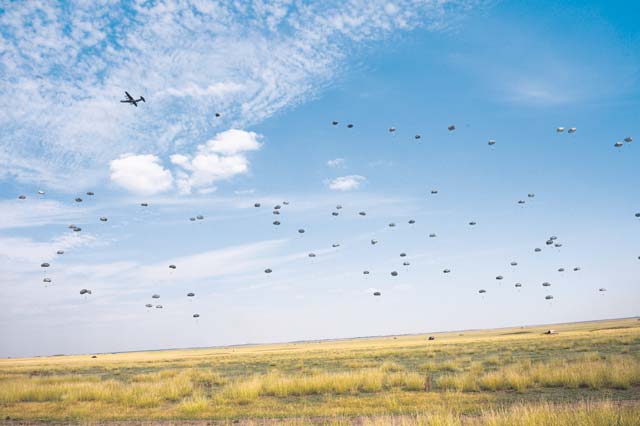
Paratroopers from Italy, Spain and the U.S. jump from aircraft to seize an airfield on Smardan Training Area, Romania. A Combined Joint Task Force was led by XVIII Airborne Corps during a joint forcible entry training exercise as part of operation Swift Response 15.
Ramstein provided rapid access capabilities for more than 5,000 service members from the U.S. and 11 NATO allies during exercise Swift Response which kicked off Aug. 17.
As a premier power projection platform and the largest mobility hub in U.S. Air Forces in Europe, the Ramstein flightline provided a stable location for allied nations to transition in and out during the exercise. By contributing this capability along with providing Airmen to ensure mission success, participants were able to build cohesive teams, strengthen relationships among allied nations and contribute to regional stability while demonstrating commitments to NATO.
Tech. Sgt. Monika Logan, 86th Operations Support Squadron NCOIC of airfield management training, and her Airmen are responsible for ensuring flight plans to the drop zones are in the Euro Control System and that all safety criteria and aircraft operating clearances are met during the exercise.
“If our flight plans for the aircraft are not in the Euro Control System, the DZ drops could be thrown off and the entire mission could be delayed,” Logan said.
Since the beginning of the exercise, Ramstein was prepared to back up 5,000 military forces, including approximately 165 Airmen.
According to Tech. Sgt. Levi Rodney, 86th OSS air traffic controller, the scale of the exercise poses unique challenges.
“We received a lot more aircraft from home stations and guard units that are going to be used during the exercise,” Rodney said. “There are a lot of Army vehicles that tend to clog up some of our operations on the ground. When they do this, they can get in the way of other aircraft, so we as controllers must make accommodations to maintain the flow of traffic below.”
Swift Response is on track to be an annual multinational exercise in Europe, designed around U.S. Army brigade-level, combined airborne and joint forcible entry operations.
Logan says this exercise is an opportunity to improve situational awareness as well as improve processes at Ramstein that involve deploying personnel and working in high-tempo areas.
“These exercises help utilize your critical thinking skills,” Logan said. “They also train us in executing contingency plans, which are of the utmost importance here.”
Swift Response is taking place in Germany, Italy and Bulgaria from Aug. 18 to Sept. 15.







